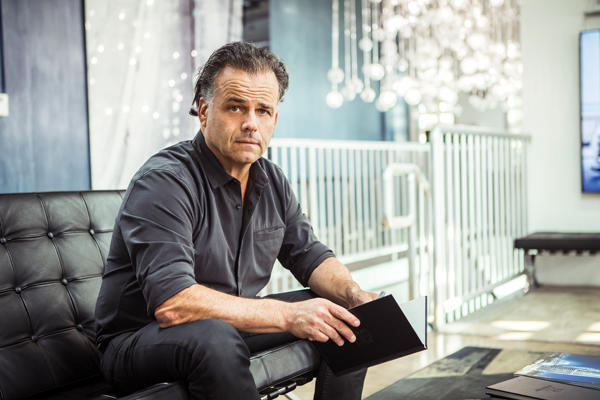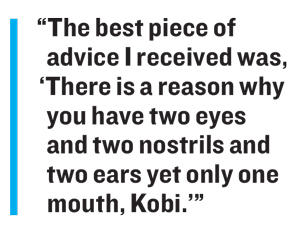Trending
Kobi Karp on design, his new office, his best advice and more

As a born multitasker, Kobi Karp seems most comfortable when he’s doing a couple things at once. When the architect recently sat down for an interview with The Real Deal at his office, clad in his typical uniform of a black button down shirt, black pants and black shoes, he had to pause the interview a few times, either to check in with the employees strolling by, to see if they need anything — they did — or to take urgent calls from his clients.
Karp, 57, oversees his architecture and design firm of roughly 80 employees alongside his wife, Nancy Karp. Their company, Kobi Karp Architecture & Interior Design Inc., is everywhere in South Florida, having designed recently completed projects such as the Four Seasons Residences and Hotel at The Surf Club (alongside Richard Meier), Palazzo Del Sol and Palazzo Della Luna on Fisher Island, Wynwood 25 and Panorama Tower. He’s designed thousands of buildings and homes over the course of his over 30-year career, including projects in Saudi Arabia, Honduras, Cambodia, Mexico, Grenada and Qatar.
The Israeli-born architect immigrated to the United States in 1974, moving with his family to Minneapolis and to Miami in 1988. Since then, he’s become a key figure in local development.
What’s the secret to his success? “I make money for developers,” he said. “What I am good at is coming up with ideas and solutions, which are unique and different from what everyone else has done before.”
But Karp, for the most part, has a sporting attitude when it comes to his rivals in the market. Nancy Karp said he calls his competitors who were previously designing projects he takes on to get their blessing. It’s a courtesy that is not always given to him, as he has sued other architecture firms for copyright infringement.
Below, Karp chats with TRD in an interview that was edited and condensed for clarity.
DOB: November 1, 1962
Hometown: Netanya, Israel, and Minneapolis
Lives in: Miami Beach
Family: Wife, Nancy, and two sons
 What is your creative process like? The creative process for me is to find the right solution at the site for the uses and the people that will be experiencing the spaces on an ongoing basis.
What is your creative process like? The creative process for me is to find the right solution at the site for the uses and the people that will be experiencing the spaces on an ongoing basis.
You’ve said it’s not the awards or reviews your buildings get that you care about. What do you care about? I saw a young couple who had just moved in [to a building I designed] and they said, ‘Oh, yeah, Kobi we live in your building.’ I kind of hold my breath to see what they are going to say.
They always like the buildings, even the buildings that have fights between the developer and contractor and 558 claims. They still like the building. They like the layouts. They like their space. They tell you, ‘I like my balcony, how it sits off the master and I can come out.’ They tell you the personal things, like, ‘I like my toilet facing the window so I can look out.’ Smart. And, that specifically was not my idea. It was actually that a toilet was facing in another direction, and the plumber said to me, “Come here, Kobi. I want to show you something,” and we turned that same toilet 90 degrees to face the window.
What’s the biggest challenge that you face when you are designing a building? The biggest challenge is the desire to provide more than the feasible budget can withhold.
What about sustainability? We need Mother Nature, Mother Earth. Arguably, that is the most important thing that we need on a daily basis, and when something small goes bad, it affects us all very deeply and very evenly, whether you are in Australia, China or California, or having a virus. It’s all part of the environment that we live in.
You purchased the Miami Ad School, where you plan to move your office. How does this fit into your move for growth? I think growth is a function of demand. This is about as big as we have been for about 10 years now. We have become more efficient due to technology improvement, and therefore our growth in production and revenue has been due to the improved technology and efficient design process of the 3D to the 2D, to the construction documents of the interior and exterior.
Is your wife involved in the business? She runs the business. And, therefore by definition, I work for her.
Does she keep you in line? It is hard to keep people in line unless they want to be in line, but I think that she is a counterbalance to me. I am more of an open-minded, design-oriented, free-flowing personality, which is important to be as a designer and as an architect. But, you need to have a counterbalance of accounting, administration, legal.
Do you think that is the secret to your success? I think that my wife happens to be a smart and strong individual, and that is a good balance to the architects and designers in this organization, who are more interested in not focusing on the daily mundane, rigid administration, accounting and legal part of the office.
I know that you are suing a new architecture firm for the second phase of Surf Club. Is that something you have had to do often? No comment.
What is the best piece of advice you have been given? The best piece of advice I received was, “There is a reason why you have two eyes and two nostrils and two ears yet only one mouth, Kobi.” Because I do like to talk. They say the more you hear and listen and breathe and think, therefore, the less you will talk or the less you will have to talk. I have learned that to be very, very, very true, and I apply that to my design. I listen more. I watch more. I breathe more. I think more. Then, I express my design in a very “keep it simple” precise way.




